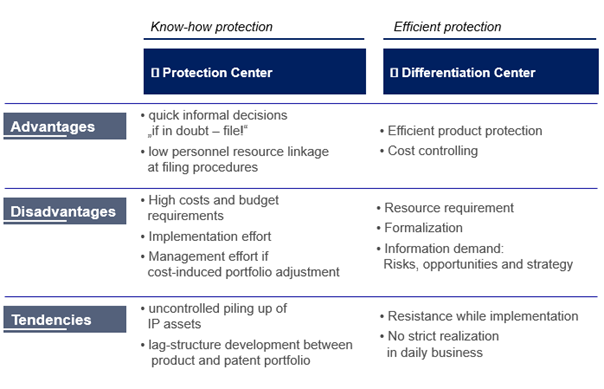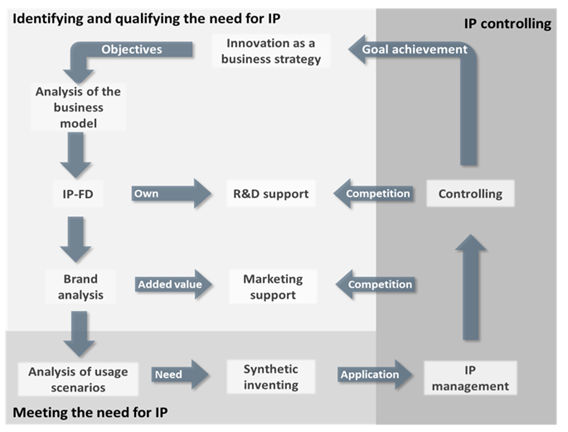Organizational Implementation of a Patent Strategy – Example Vorwerk Thermomix
The starting point of a company’s organization is the appropriate division of labor. The challenge is to quantitatively distribute the workload and qualitatively distribute the various requirements for the work to be performed. The division of labor creates interfaces and interactions between employees and organizational areas that need to be optimized according to business objectives such as efficiency, flexibility, result orientation, effectiveness, and controllability. The overall organizational objective should be an organization designed to fulfill the strategy structure fit requirement: The organizational structure as a control system and infrastructure to implement a strategy. The strategy-structure fit thus specifies a quality criterion for an organizational structure.
Alfred D. Chandler is a historian of business and strategy and he published 1962 his book: “Strategy and structure: Chapters in the history of the American industrial enterprise”. He defines strategy as the determination of the basic long-term goals and objectives, the adoption of courses of action and the allocation of resources necessary for achieving goals. He defines structure as the design of the organization through which the business is administered including the lines of authority and communication and the data that flows through these lines. The consequence of Chandlers work is clear: When a company wants to implement IP design, it needs an appropriate organization. IP design is the ability of an organization to optimize IP impacts according to its business needs, which means especially that the organization is able to create the needed IP on purpose to enjoy the suitable exclusivity for the respective business model.
The state of the organizational discussion in patent an IP management focuses on four lines of argumentations:
- organizational structure,
- process organization,
- task and functional organization as well as
- IP culture.
Strategy and organizational structure have a strong interdependency. According to Chandler, the structure has to follow the strategy. While at the same time strategic options may arise from external changes which makes organizational changes necessary, the organizational structure also limits the strategic possibilities of a company. Crucial for the practical management of IP is to provide a structure strategy fit and to check it regularly, so that the given business model, the company’s IP strategy and its targets and thus also the organizational structure for the implementation of this strategy fit together. Individual organizational elements, such as patent or portfolio evaluation criteria, must be consistent and derived from the business objectives and thus represent the basis for sensible controlling.
IP design and the implementation of a differentiation strategy – the example of Vorwerk Thermomix
The case study Vorwerk describes an organizational implementation of the strategy for the product Thermomix according to IP design. The Thermomix is a multifunctional kitchen machine and the manufacturer Vorwerk is running a differentiation center. A differentiation center is the organizational implementation of a differentiation strategy. Such a market and competitive strategy focuses on customer-relevant unique selling points (USPs) and thus avoids an insulated price comparison with competitive offers by the customer. This strategy is addressing immediate customer benefits which are perceived by customers and reported by a willingness to pay for the added value. Opposed to this are the general product characteristics, in which from the customer’s perspective is not always clear what kind of benefits they provide.

The differentiation properties of the Thermomix that are oriented towards customer benefits include, for example, memory chips with recipe data that guide the user step by step through the cooking process, a sophisticated safety concept, and an intuitive user interface that even allows recipes to be interrupted, steps skipped and influenced so that the operator always masters the cooking process to produce the desired meal. This so-called guided cooking leads to a significantly different customer perception compared to competing products and to a clear unique position of the product. To make this a unique selling proposition perceived by the customer and legally enforceable, the IP strategy of the value-added monopoly is integrated into the differentiation approach. This is reached, because not just primary product characteristics are patented, but rather the technical basis for the possible perceived customer value will be blocked for the competition. IP design is used to create an IP portfolio which influences the customer’s decision, due to a lack of comparability of third-party products.
Such an IP strategy, which is based on the advantage of differentiation from the customer’s perspective and not primarily on built-in product features, must be anchored in the organization. The link between the strategy and organization is provided in two operating parts of an IP management system: identifying needs of IP and the needed customer benefits. In order to determine and characterize the IP needs, the desirable exclusivity areas are derived from the business model as well as from the market and competitive strategy of the differentiation approach. This need for exclusivity is then systematically covered by prohibition rights, which in turn are specifically created through synthetic inventions.

In the differentiation competition, a portfolio of prohibitive rights must primarily provide exclusivity for the achievement of a premium price. The prerequisite for an effective IP portfolio is to know one’s own IP needs precisely. The IP need depends on the customer benefit arguments which are used. With the Thermomix, for example, guided cooking, automatic recipes, flexibility, and successful cooking are the corner stones of the benefit communication. The technical basics for these arguments are patented, and their benefits are communicated. So, as a result of this differentiation strategy, the product is perceived in the customer target group as exclusive with these benefit characteristics and the price premium is accepted. Still today the Thermomix is running a price premium strategy and is very successful.
Central success factors for Vorwerk’s IP design implementation
The unique market position of the Thermomix with the consequence of the achievement of premium prices and a continuous expansion of the market presence is proof of the success not least because of the patent and IP portfolio. The differentiation center to implement the IP strategy has been used for over six years and controlled according to the portfolio. From this experience, several success factors for the IP work can be summarized:
- Integration of the market intelligence: From the determination of the need, to the design of the patents to reporting, it is important to integrate the market intelligence into the patent process.
- Design of prohibitive IP along the customer value and benefits: The prohibition effect of patents must secure the exclusivity of the perceived customer values in a differentiation center.
- Thinking IP from the customer decision: Knowing which competencies and performance features are perceived by the customer and can be influenced by IP.
- Usage of impact data for the continuous improvement of IP designs: Control loops from the impact assessment to the design of the IP are the basis for a continuous improvement process to optimize the IP effect in the business model.
The questions for this case study are:
1 . What is the structure strategy fit and what is the relation between the patent strategy and the organizational structure of a company?
2 . What is the patent strategy of Vorwerk during the development of the Thermomix?
3 . Which processes and organizational components did Vorwerk implement to create a fit with this strategy?
4 . Which organizational requirements are caused by the tasks of the 360° IP strategy used by Vorwerk?
Group 1:
Claire Laurens de Lopez, Nora Rüter, Véronique Bolinches, Clement Lim, Andrea Foglia, Sachin Seshadri, Steffen Rutter, Konstantinos Kontogiannis
Cannot open the video? Please click: https://youtu.be/tmIHKnTmNuA
Group 2 :
Terita Kalloo, Greta Zekiene, Maria Boicova-Wynants, Anders Isaksson, Felipe Bustos, Branimir Puškarić, Timofey Rubchenko, Peter Conlon, Rita Labundy
Cannot open the video? Please click: https://youtu.be/sbsxfIL4_UA
Group 3:
Merve Şimşek, Johannes Holzmair, Nina Kolar, Shu-Pei Oei, Andreas Werner, Yanan Huang, Sinara Travisani Cardozo, Mohsen Ahmadi, Ricardo Cali
Cannot open the video? Please click: https://youtu.be/YSK7w1zNkn0
Thanks to Centre d’Etudes Internationales de la Propriété Intellectuelle – CEIPI If you want to learn more: Follow us at IP Business Academy



